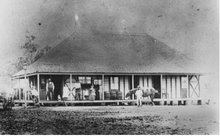One of the first things we did to the house when we bought it was to have a toilet put in the bathroom of the main part of the house. With small children, the last thing you want to do is to have them traipsing down a flight of open-riser stairs to use the facilities at night although we did this for a year. And all of the light switches were well above child level. The plumber simply cut a hole in the bathroom floor and suspended the pipework under the house to the existing septic tank. The only problem then was that we had to move the bathroom door around the corner because health regulations don’t allow a bathroom with a toilet to open onto a kitchen. See what troubles you start getting into when you change things?
About 18 months ago now, we demolished the lean-to laundry, jack-hammered out the immensely thick concrete slab and positioned the new part of the house in that location. We took out the bathroom of the removal house to make the wide hallway that connects the two houses but we kept the toilet which was in a separate room. We did have to replace the toilet so that it was a model suitable for septic tanks instead of a “town sewage” model. I had never known that there were different standards for fittings based on type of sewerage. The things you learn.
So here we are on Saturday night – worried that after everything, something has gone wrong with the septic tank. The 24 hour septic tank bloke assured me that it was probably the trench and that he would be there first thing on Monday. Around midday on Monday, the truck arrived. Pretty soon he started making harrumphing noises that I know mean trouble. He couldn’t get the eel into the outlet pipe so he decided to dig down the side of the tank to find the inspection access point. I could have guessed that there wouldn’t be one. As he dug the hole started filling with liquid. A few more harrumphs and he quietly shovelled the dirt back in. His taciturnity turned to verbosity.
“You need a plumber. The seal has gone. And you need to show the plumber the diagram that you have of the property that shows where the trench and the connections are so he can make a new connection to the trench. Then he can get the eel in and find out what is wrong with the drainage. I’ll drain the tank while you call the plumber and tell him that it’s an emergency. Won’t get them out here within a month otherwise and you’ve got two weeks, depending on your deposit rate.”I don’t know if it was the prospect of dealing with an empty tank or the fact that I can see the plumber’s house from ours, but he’s coming on Wednesday morning. He’s not cheap but he does a great job and is totally unfazed by the fact that there are no diagrams and in fact no actual knowledge of where the trench may be. We have our suspicions. There’s a patch of grass that stays green in the driest months but it might just be an outlet and not a trench at all.
I’m hoping for the sweet smell of success rather than…well you can imagine the rest.

No comments:
Post a Comment